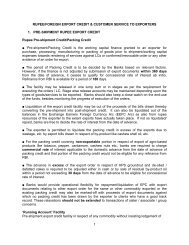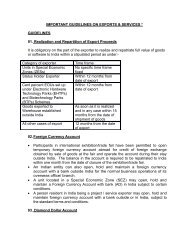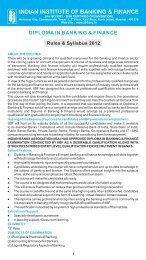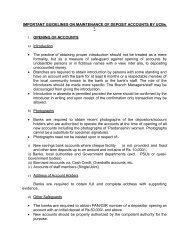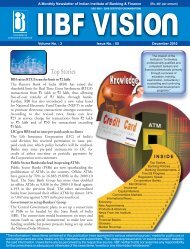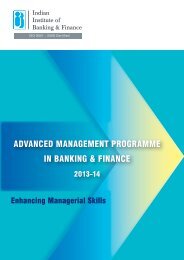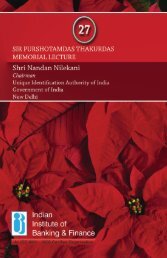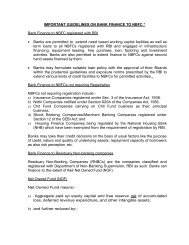Create successful ePaper yourself
Turn your PDF publications into a flip-book with our unique Google optimized e-Paper software.
special featureprivate sector ones. This inference is naturally expectedsince traditionally PSBs have been a parking lot forgovernment's borrowing program.Asset quality :GNPANA NNPANA TITA NNPATAPSBPVTB PSB PVTB PSB PVTB PSB PVTBMean 1.50 2.33 0.62 0.93 27.44 29.72 0.37 0.51t Stat -2.02 -1.49 -2.14 -1.25Significance ** - ** -** Significant at 5%The asset quality of PSBs is superior as reflected in theratio of Gross NPA to Net Advances (t =-2.02). However,there is no significance difference between PSBs andprivate sector banks in the ratio net NPA to NetAdvances. This is again corroborated in the ratio of netNPAs to Total Assets. This means though Private sectorbanks have higher gross NPAs but their provisioningis also higher and thereby the Net NPA ratios arecomparable to those of PSBs.In 2009, the Reserve Bank advised SCBs to maintainprovisioning to NPA ratio to not less than 70 pc bySeptember 2010. Between 2009 and 2010, the coverageratio of provisions to NPAs of SCBs declined from52.1 per cent to 51.5 per cent (RBI, 2010). The declinein coverage ratio could be seen mainly in the caseof nationalized banks. The ratio declined substantiallyby about 8 percentage points for nationalized banksbetween 2009 and 2010. As against this decline, the ratioincreased by about 7 percentage points for private sectorbanks (RBI, 2010).Management :TADVTD PPE BPEPSB PVTB PSB PVTB PSB PVTBMean 70.83 69.50 0.049 0.041 7.95 5.67t Stat 0.53 0.690 2.14Significance - - **** Significant at 5%After the advances, the second most important categoryof income-generating assets is investments made bythe bank. Here, the private sector banks have higherproportion of funds locked up in investments than PSBs(t = -2.14). This finding is on expected lines since onthe capital adequacy parameter, it was found thatthe advances to total assets ratio was higher in caseof PSBs.The parameter management reflects the productivity ofthe manpower in a bank. We observe that there is nosignificant difference in private and public sector bankson the parameter total advances to total deposits. ThePPE, a measure of branch level employee productivity, ismarginally higher in case of public sector banks, but thedifference is not significant statistically. For the FY 2010,the mean profit per employee for PSBs is at `4,90,560,against a mean of `4,14,330 for PVTBs. However, forFY 2010, mean business per employee of public sectorbanks (`7.95 crore) is far higher than the privatebanks (`5.67 crore). This is highly significant difference(t = 2.14). This is a pointer to poor operating efficiencyof PSBs, who are not able to generate higher profitabilitydespite higher business. The higher operating costsof PSBs are constituted largely by employee costs. Mostof the PSBs have large legacy manpower, whereasthe PVTBs have focused on technology to drive theirbusiness and employ far less manpower.Earnings :OPAWF NIM PATAA IITI NIITIPSB PVTB PSB PVTB PSB PVTB PSB PVTB PSB PVTBMean 1.92 2.19 2.18 2.51 0.97 0.90 86.91 84.69 13.09 15.31t Stat -0.93 -1.72 0.39 1.96 0.68Signifi- - - * - - - ** - - -cance** Significant at 5% * Significant at 10%We saw earlier that PVTBs had higher PPE despite theirBPE being lower than PSBs. This is further supported bythe findings in ratio of operating profits to averageworking funds. Though there is no statistical differencebetween the operating profits to average working fundsratio of these two categories of banks, the mean ratio ofPSBs is lower than PVTBs.Another critical measure of bank profitability is spread.As anticipated, we find significant difference in NIMs ofboth the categories of banks. However, an importantobservation here is that though traditionally PSBs havehad access to low-cost deposits, their NIM is lowerthan private sector counterparts owing to lower interestThe Journal of Indian Institute of Banking & Finance October - December 2011 49



